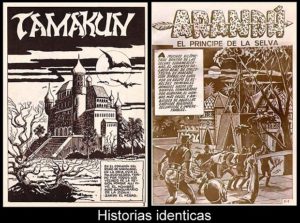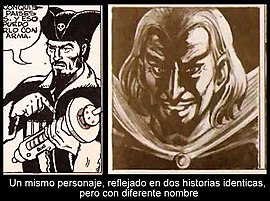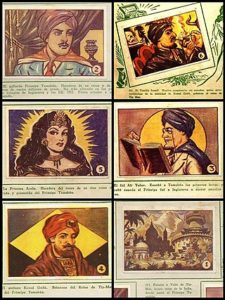 “TAMAKÚN, EL VENGADOR ERRANTE”, LUCHADOR POR LA LIBERTAD Y CONTRA LA ADVERSIDAD.
“TAMAKÚN, EL VENGADOR ERRANTE”, LUCHADOR POR LA LIBERTAD Y CONTRA LA ADVERSIDAD.
Tamakún, el vengador errante es un personaje ficticio creado por el escritor, compositor y empresario José Obelleiro Carvajal nacido en Pinar del Rio, Cuba y que fuera emitida radialmente por la emisora R.H.C, Cadena Azul desde el 1 de diciembre de 1941. En ese entonces el personaje de “Tamakún” fue personalizado por Jesús Alvariño Govante, un destacado actor de la antigua radio y televisión Nacional Cubana.
La radionovela pronto se extiende a otros países latinoamericanos.
El nombre surge como derivado de “Tamakan” en la imaginaria isla de Tailuma en la India. Bajo el tema “Tamakún” servía de cortina para la radionovela. Allí reinaba el Rey Kemal (padre del príncipe Tamakún) y su esposa. El Rey Kemal Geda envió a Tamakún a una misión en las fronteras del reino, porque se habían dado reportes de unos bandidos que estaban saqueando. Esta situación fue aprovechada por Iraseff, hermano del rey Kemal quien luego de acceder al palacio a través de un acceso secreto, asesina al rey, su esposa y la joven Arelis (novia de Tamakun). Iraseff toma el poder en el reino de Tip Mai, desencadenando el terror y la opresión del pueblo, además mantiene como rehén a Roxana, la hermana pequeña de Tamakún.
Al enterarse de lo ocurrido, Tamakún decide vengar la muerte de sus padres y de paso restaurar la paz y la justicia en el reino. Organiza, junto a su amigo Alí Yabor un ejército de campesinos el cual se convertirá en un inseparable compañero de aventuras por todo el mundo.
La radionovela es un éxito comercial, y se comercializa el álbum de barajitas. Tiene 200 barajitas para pegarse en un total de 18 páginas, 22 centímetros de ancho y 30,50 centímetros de altura. A nivel histórico tienen gran valor, debido a que tenemos una referencia de los nombres originales y sus aspectos físicos según se narraban en la radio.
Surge una nueva “versión” de Tamakun.
En 1969 Armando Couto un destacado autor cubano exiliado, usa la trama para crear: ‘Arandú, el príncipe de la selva’, en México. Cambia los nombres claves: El protagonista (Tamakun ahora es Arandú) y su ayudante ahora es un africano gigantesco y fuerte llamado ‘Toloamba’, tiene aspecto “tarzanizado”, los reyes son asesinados por ‘Avantar’ (Sakiri), la ciudad ahora se llama Italco – Tzuyo (Saracardi), Arandú convoca a su pueblo (ahora indígena) para destronar a su malvado tío, como es obvio, la trama es idéntica a la de Tamakun.
En 1970 Arandú surge como cómic. El origen de Arandú es idéntico al de Tamakun pero en la siguiente aventura ya toma su propio rumbo, diferenciándose de las aventuras de Tamakun de allí en adelante.
Tamakún convertido en Arandú comienza en historietas. En 1975 aparecen sus aventuras en historietas. El guion es de Armando Couto. La historia es básicamente la misma, se cambian algunos nombres y se anexan algunos personajes:
Cambia el nombre del tío malvado, de Iraseff a ‘Sakiri el Negro’. El reino de Tip Mai cambia a Saracardi. El rey pasa de llamarse Kemal Geda a ‘Kramitar’. Se anexan: ‘Zorka’, aliado de Tamakun.. Omar Jarun, el sabio ‘Sartori’, el teniente ‘Mohamad’. El personaje “Sakiri” aparece de nuevo en algunas aventuras de “Los Tres Villalobos” cuando se descubre su presencia en estas como “Sakiri el Malayo”.
En las historietas de Armando Couto además de Sakiri, aparecen más enemigos: ‘El gran Mongol’, un hombre gigantesco, cruel, gran fortaleza física, a quien le falta una mano y usa ese espacio para encajar cuchillos, lanzallamas, y granadas, Hombres Mastines, ‘Barrabás’ el pulpo que come carne humana, el teniente Alan, Beroli.
Hay diferencia cuando Tamakun tiene un atuendo de turbante blanco y su origen de Oriente Medio y copia la parte detectivesca de Chan Li Po (1934). La frase: “serenidad y paciencia, mucha paciencia” es evidentemente una copia de Po: “tengan paciencia, mucha paciencia”.
Tamakun era un personaje bélico, se muestran escena gráficas de violencia, explosiones y peleas. Tamakun dejó una enseñanza a sus escuchas y lectores: La lucha por la libertad y no rendirse ante las adversidades. La perseverancia, la importancia de la amistad son elementos recurrentes en sus historias.
 “TAMAKÚN, THE ERRANT AVENGER”, FIGHTER FOR FREEDOM AND AGAINST ADVERSITY.
“TAMAKÚN, THE ERRANT AVENGER”, FIGHTER FOR FREEDOM AND AGAINST ADVERSITY.
Tamakún, the wandering avenger is a fictional character created by the writer, composer, and businessman José Obelleiro Carvajal born in Pinar del Rio, Cuba, and which was broadcast on the radio by the RHC radio station, Cadena Azul since December 1, 1941. At that time the character of “Tamakún” was personalized by Jesús Alvariño Govante, a prominent actor from the old Cuban National Radio and Television.
The radio soap opera soon spreads to other Latin American countries.
The name arises as a derivative of “Tamakan” on the imaginary island of Tailuma in India. Under the theme “Tamakún” it served as a curtain for the radio soap opera. King Kemal (father of Prince Tamakún) and his wife reigned there. King Kemal Geda sent Tamakún on a mission to the borders of the kingdom because there had been reports of bandits who were looting. This situation was taken advantage of by Iraseff, King Kemal’s brother, who after entering the palace through secret access, assassinated the king, his wife, and the young Arelis (Tamakun’s girlfriend). Iraseff takes power in the kingdom of Tip Mai, unleashing the terror and oppression of the people, and he also holds Tamakún’s little sister Roxana hostage.
Upon learning what happened, Tamakún decides to avenge the death of his parents and incidentally restore peace and justice in the kingdom. He organizes, together with his friend Alí Yabor, an army of peasants who will become an inseparable companion of adventures throughout the world.
The radio soap opera is a commercial success, and the album of cards is commercialized. It has 200 cards to stick on a total of 18 pages, 22 centimeters wide, and 30.50 centimeters high. On a historical level, they have great value because we have a reference to the original names and their physical aspects as they were narrated on the radio.
A new “version” of Tamakun is emerging .
In 1969 Armando Couto, a prominent exiled Cuban author, uses the plot to create: ‘Arandú, the prince of the jungle’, in Mexico. Change the code names: The protagonist (Tamakun is now Arandú) and his assistant are now a gigantic and strong African called ‘Toloamba’, he has a “tarzanized” appearance, the kings are killed by ‘Avantar’ (Sakiri), the city is now called Italco – Tzuyo (Saracardi), Arandú summons his people (now indigenous) to dethrone his evil uncle, as is obvious, the plot is identical to Tamakun’s.
In 1970 Arandú emerged as a comic. Arandú’s origin is identical to Tamakun’s but in the next adventure, he already takes his own course, differentiating himself from Tamakun’s adventures from then on.
Tamakún turned into Arandú begins in comics. In 1975 his adventures appear in comics. The script is by Armando Couto. The story is basically the same, some names are changed and some characters are added:
Change the evil uncle’s name from Iraseff to ‘Sakiri the Black’. Tip Mai’s kingdom changes to Saracardi. The king goes from being called Kemal Geda to ‘Kramitar’. Attached are: ‘Zorka’, Tamakun’s ally .. Omar Jarun, the sage ‘Sartori’, Lieutenant ‘Mohamad’. The character “Sakiri” appears again in some adventures of “Los Tres Villalobos” when his presence is discovered in these as “Sakiri el Malayo”.
In Armando Couto’s comics in addition to Sakiri, more enemies appear: ‘The great Mongol’, a gigantic, cruel man, great physical strength, who is missing a hand and uses that space to fit knives, flamethrowers, and grenades, Men Mastiffs, ‘Barabbas’ the octopus that eats human flesh, Lieutenant Alan, Beroli.
There is a difference when Tamakun has a white turban outfit and his Middle Eastern origin and copies the detective part of Chan Li Po (1934). The phrase: “serenity and patience, a lot of patience” is evidently a copy of Po: “be patient, a lot of patience.”
Tamakún was a warlike character, graphic scenes of violence, explosions and fights are shown. Tamakun left a lesson to his listeners and readers: The fight for freedom and not giving up in the face of adversity. Perseverance, the importance of friendship are recurring elements in their stories.
Agencies/ Wiki/ Extractos/ Excerpts/ Internet Photos/ Arnoldo Varona/ www.thecubanhistory.com
THE CUBAN HISTORY, HOLLYWOOD.













